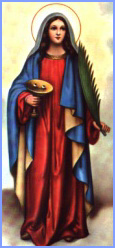|
History
of Santa Lucia
A
thousand years ago in Sweden, King Canute declared that
Christmas would last a month, from December 13, the feast of St.
Lucia until January 13, or Tjugondag Knut (St. Canute's
Day). No one is quite sure why Lucia, a 4th century Sicilian
saint, came to be so revered in Sweden. Some say she once
visited the country, and others believe that Christian
missionary stories of her life entranced the Swedish people.
Whatever the origin, these new Christians who converted to
Christianity around 1000 acquired a special fondness for the
saint whose feast day marked the return of the sun and whose
name itself means "light."
Santa
Lucia is celebrated all over Sweden and in Norway on December
13th. The custom--a young girl dressed in white with candles on
her head--has a complicated background, more fiction than fact.
Its origin is from 16th century Germany, but it is combined with
the Middle Ages custom of celebrating before a fast.
 The
Italian Santa Lucia (d. 304, Syracuse, Sicily; feast day
December 13) was a virgin and martyr who was one of the earliest
Christian saints to achieve popularity, having a widespread
following before the 5th century. She lived in Syracuse, a town
on the Italian island of Sicily. She is the patron saint of the
city of Syracuse. Because of various traditions associating her
name with light, she came to be thought of as the patron of
sight and of the blind and was depicted by medieval artists
carrying a dish containing her eyes. The
Italian Santa Lucia (d. 304, Syracuse, Sicily; feast day
December 13) was a virgin and martyr who was one of the earliest
Christian saints to achieve popularity, having a widespread
following before the 5th century. She lived in Syracuse, a town
on the Italian island of Sicily. She is the patron saint of the
city of Syracuse. Because of various traditions associating her
name with light, she came to be thought of as the patron of
sight and of the blind and was depicted by medieval artists
carrying a dish containing her eyes.
According
to apocryphal texts, the beautiful Lucia came from a wealthy
Sicilian family. In the days of early Christian persecution,
Lucia is said to have carried food to Christians hiding in dark
underground tunnels. To light the way she wore a wreath of
candles on her head. Spurning marriage and worldly goods, she
vowed to remain a virgin in the tradition of St. Agatha. An
angry suitor reported her to the local Roman authorities, who
sentenced her to be removed to a brothel and forced into
prostitution. This order was thwarted, according to legend, by
divine intervention and Lucia became immovable and could not be
carried away. She was next condemned to death by fire, but she
proved impervious to the flames. Finally, her neck was pierced
by a sword and she died. In actuality, Lucia was probably a
victim of the wave of persecution of Christians that occurred
late in the reign of the Roman emperor Diocletian. References to
her are found in early Roman sacramentaries and at Syracuse in
an inscription dating from AD 400. As evidence of her early
fame, 2 churches are known to have been dedicated to her in
Britain before the 8th century, at a time when the land was
largely pagan.
One of
the patron saints of virgins, St. Lucia is venerated on her
feast day, December 13, by a variety of ceremonies. At one time,
December 13th was the shortest day of the year--St. Lucia, the
queen of light, was believed to lead the way for the sun to
bring longer days. People lit "St. Lucy's fires" on
the evening of her feast day, throwing incense into the flames.
They then bathed in the smoke, believing it would protect them
from witchcraft, disease, and other dangers. Music was played to
accompany the sun's changing course.
In
Sweden, St. Lucy's Day marks the beginning of the Christmas
celebration. The night before, children leave their shoes
outside in order to collect her offerings. Then in the morning,
the eldest daughter in each family dresses in a white dress with
a red sash, and wears an evergreen wreath with 7 lighted candles
on her head. She carries coffee and buns to each family member
in his or her room. A traditional song is sung:
Santa
Lucia, thy light is glowing
Through darkest winter night, comfort bestowing.
Dreams float on dreams tonight,
Comes then the morning light,
Santa Lucia, Santa Lucia.
|